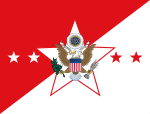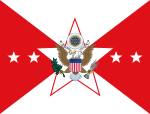J. H. Binford Peay III
| J.H. Binford Peay III | |
|---|---|
|
General James Henry Binford Peay III 24th Vice Chief of Staff of the United States Army | |
| Nickname(s) | Binnie |
| Born |
May 10, 1940 Richmond, Virginia |
| Years of service | 1962–1997 |
| Rank |
|
| Commands held |
101st Airborne Division CENTCOM |
| Battles/wars |
Vietnam War Desert Storm |
| Awards |
Defense Distinguished Service Medal Army Distinguished Service Medal (2) Silver Star Defense Superior Service Medal Legion of Merit (2) Bronze Star (4) Purple Heart |
| Other work |
Superintendent, Virginia Military Institute Chairman, Allied Defense Group Director, BAE Systems Inc. |
James Henry Binford "Binnie" Peay III (born May 10, 1940, in Richmond, Virginia) is a retired four-star general from the United States Army and is currently the 14th Superintendent of the Virginia Military Institute.
He is also chairman of the Allied Defense Group and a director of BAE Systems Inc. He is a trustee of the George C. Marshall Foundation, the National Defense University, and the VMI Foundation.
Early life
Peay attained the rank of Eagle Scout in the Boy Scouts of America in 1954 and as an adult is a recipient of the Distinguished Eagle Scout Award from the BSA.[1] His father, Peay Jr. and both of his sons, Jim and Ryan, are also Eagle Scouts.[2]
He graduated from the Virginia Military Institute in 1962 with a Bachelor of Science degree in Civil Engineering. He also has a Master of Arts from George Washington University and is a graduate of the U.S. Army War College.
Military service
He was commissioned as a second lieutenant of Field Artillery in 1962. Peay’s initial troop assignments were in Germany and Fort Carson, Colorado. From December 1964 to September 1966, he served as aide-de-camp to the Commanding General, 5th Infantry Division. He went on to serve in other assignments including two tours in the Republic of Vietnam. In his first tour from May 1967 to July 1968, he commanded both Headquarters Company, I Field Force, Vietnam, and a firing battery (Battery B, 4th Battalion, 42d Artillery) with the 4th Infantry Division in the central highlands. During his second tour from August 1971 to June 1972, he served as the assistant operations officer for the 3d Brigade, 1st Cavalry Division, and as operations officer for the same division’s 1st Battalion, 21st Artillery.
After serving with the Army Military Personnel Center in Washington, D.C., as a Field Artillery branch assignments officer, Peay was sent to Hawaii in 1975 to command the 2d Battalion, 11th Field Artillery, 25th Infantry Division. Following completion of the Army War College, he returned to Washington, D.C., as Senior Aide to the Chairman of the Joint Chiefs of Staff, and later as Chief of the Army Initiatives Group in the Office of the Deputy Chief of Staff for Operation and Plans. He then moved to Fort Lewis, Washington, to serve as the I Corps’ Assistant Chief of Staff, G-3/Director of Plans and Training, and later became Commander, 9th Infantry Division Artillery. In 1985, he returned to Washington, D.C., as Executive to the Chief of Staff, United States Army. He first became a "Screaming Eagle" in July 1987, when he became the Assistant Division Commander (Operations), 101st Airborne Division (Air Assault) at Fort Campbell, Kentucky. Beginning in July 1988, he served a one-year assignment as Deputy Commandant, Command and General Staff College, Fort Leavenworth, Kansas.
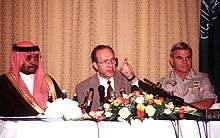
On August 3, 1989, Peay returned to Fort Campbell to assume command of the 101st Airborne Division and led the division through Operations Desert Shield and Desert Storm in the Persian Gulf. Promoted to the rank of lieutenant general, he was the Army’s Deputy Chief of Staff for Operations and Plans, and Senior Army Member, United States Military Committee from June 1991 until March 1993. He was promoted to general on March 26, 1993 and appointed as the Army’s twenty-fourth Vice Chief of Staff. His last active duty position was as Commanding General, United States Central Command, at MacDill Air Force Base, Florida, from August 5, 1994 until August 13, 1997.
Peay's awards and decorations include the Defense Distinguished Service Medal, the Army Distinguished Service Medal with oak leaf cluster, the Silver Star, the Defense Superior Service Medal, the Legion of Merit with oak leaf cluster, the Bronze Star with three oak leaf clusters, and the Purple Heart. He has also received the Meritorious Service Medal with two oak leaf clusters, several Air Medals, and the Army Commendation Medal. Additionally, he wore the Parachutist Badge, Ranger Tab, the Air Assault Badge, the Secretary of Defense Identification Badge, Joint Chiefs of Staff Identification Badge, and the Army General Staff Identification Badge.
 |
 | |||
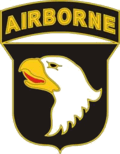 |
 | |||
 |
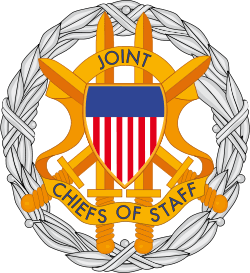 |
 | ||
Professional career
After retirement from the Army, he became a director at United Defense Industries (UDI) in 1997. In 2005 BAE Systems purchased UDI and appointed Peay to the board of its North American subsidiary, BAE Systems Inc.
He joined Allied Research Corporation in March 2000 as member of its board of directors. Allied is a diversified defense and security firm, providing conventional medium caliber ammunition and sophisticated security systems. In January 2001, he was made chairman, president and CEO. In 2003, the company was renamed Allied Defense Group.
Peay resigned in June 2003 to assume the position of superintendent of Virginia Military Institute, but remained the non-executive chairman at Allied.
References
- ↑ "Distinguished Eagle Scouts" (PDF). Scouting.org. Retrieved 2010-11-04.
- ↑ Townley, Alvin (2006-12-26). Legacy of Honor: The Values and Influence of America's Eagle Scouts. New York: St. Martin's Press. pp. 219–227. ISBN 0-312-36653-1. Retrieved 2006-12-29.
External links
| Wikimedia Commons has media related to J.H. Binford Peay III.. |
Air Assault in the Gulf: An Interview with M.G. J.H. Binford Peay. United States Army Center of Military History.
| Military offices | ||
|---|---|---|
| Preceded by Gen. Dennis Reimer |
Vice Chief of Staff of the United States Army 1993–1994 |
Succeeded by Gen. John H. Tilelli, Jr. |
| Preceded by Joseph P. Hoar |
Commander-in-Chief of United States Central Command 1994–1997 |
Succeeded by Anthony Zinni |
